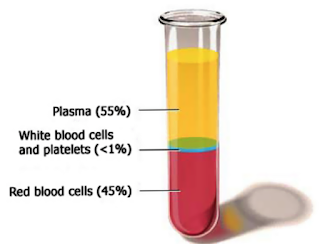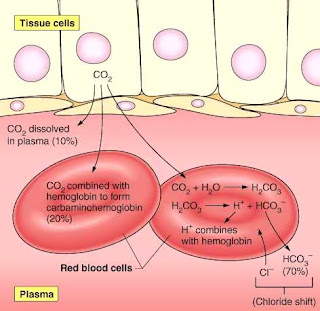SPM Biology 10 Transport: Platelet, Plasma and the Functions of Blood
Platelet
Plasma
1. Plasma is a pale yellowish liquid consisting of 90% water and a large number of dissolved substances, such as :
- Digested food materials: glucose, amino acids, fatty acids, etc.
- Excretory products: urea, uric acid, etc.
- Mineral in the form of ions: calcium, sodium, potassium, etc. and vitamins.
- Dissolved gases.
- Plasma proteins such as albumin, globulin and fibrinogen.
- Hormones.
 |
| Composition of blood |
Functions of blood
1. Transport of oxygen
- Blood transport oxygen in the form of oxyhaemoglobin.
- In the alveolus, the partial pressure of O₂ is higher than the partial pressure of O₂ in the blood capillary.
- Hence, O₂ diffuses out from the alveolus into the blood capillary around the alveolus by simple diffusion.
- In the blood, O₂ combines with haemoglobin in the erythrocyte to form oxyhaemoglobin.
- O₂ is transported in the form of oxyhaemoglobin to the body cells which lack of O₂.
- At the body cells, oxyhaemoglobin breaks down to release the O₂ to the body cells for cell respiration.

Formation of haemoglobin
- CO₂ is transported by the blood in 2 main forms: Ion bicarbonate and carbaminohaemoglobin.
- CO₂ is transported from the body cells to the lungs to be removed during exhalation.
- In the body cell, as a result of respiration which release CO₂, the partial pressure of CO₂ is higher then in the blood capillary.
- In the blood capillary, CO₂ dissolves in the blood plasma to form hydrogen carbonates ion and is transported in the blood plasma to the lungs.
- At the lungs, enzyme changes the hydrogen carbonate ion to CO₂ again.
- The CO₂ then diffuses out of the blood capillary into the alveolus to be removed during exhalation.
- CO₂ can also be transported in the form of carbaminohaemoglobin which is then transported in the erythrocyte to the lungs.
- At the alveolus, carbaminohaemoglobin breaks down to release the CO₂ which then diffuse into the alveolus to be expelled out during exhalation.

Transport of carbon dioxide
- Plasma transport digested food such as simple sugars, amino acids, fatty acids, glycerol, vitamins and dissolved minerals.
- Simple sugars, amino acids, minerals and vitamins B and C are absorbed into the blood capillaries in the villus of the ileum.
- These nutrients are then transported in the plasma from the ileum to the liver through the hepatic portal vein, then to the heart and subsequently to the whole body for usage or storage.
- Fatty acids, glycerol, vitamins A, D, E, K diffuse into the lacteal of the villus and are transported from the ileum to the lymphatic system, then back into the circulatory system through the left subclavian vein. The food materials are then transported in the plasma to the whole body.
- Nitrogenous wastes such as urea are by products of protein metabolism.
- Urea, uric acid. cretinine, bilirubin and ammonium ions are transported to the kidneys to be excreted.
- Endocrine glands secrete hormones into the bloodstream which are then transported by the plasma to the target organs.
- For example, the insulin hormone is transported by the blood plasma from the pancreas to liver where it acts.
- Heat is produce during cell respiration which occurs actively in the muscles and liver.
- The heat is distributed evenly throughout the whole body by the circulatory system.
- Excess heat can be removed by transporting it to the skin and the lungs by the blood so that the heat is dissipated.
- Water is universal solvent. It acts as a medium for all chemical reactions to take place in the body.
- The blood transports water to the whole body to regulate the equilibrium of water and osmotic pressure in the body.

No comments:
Post a Comment